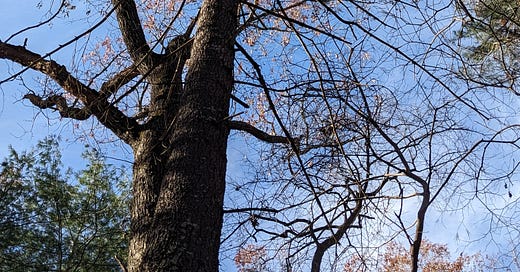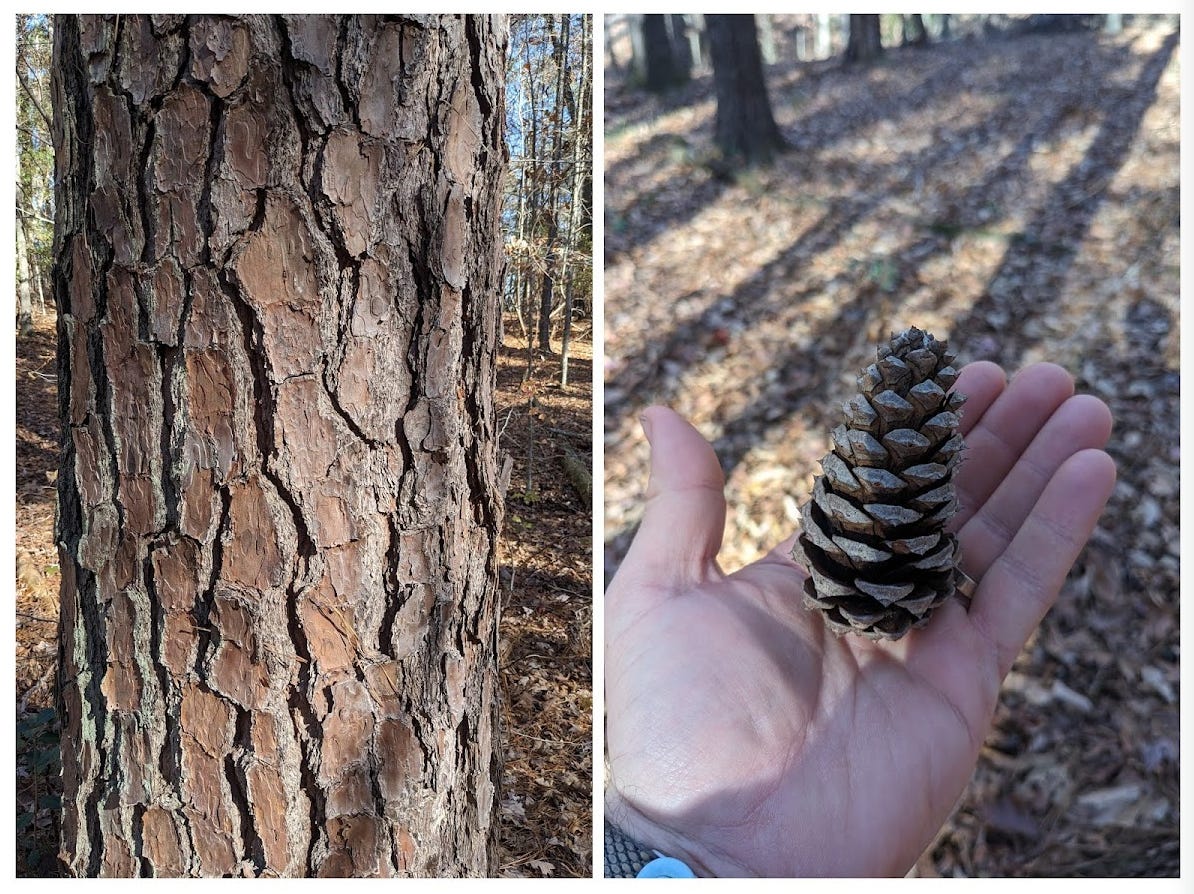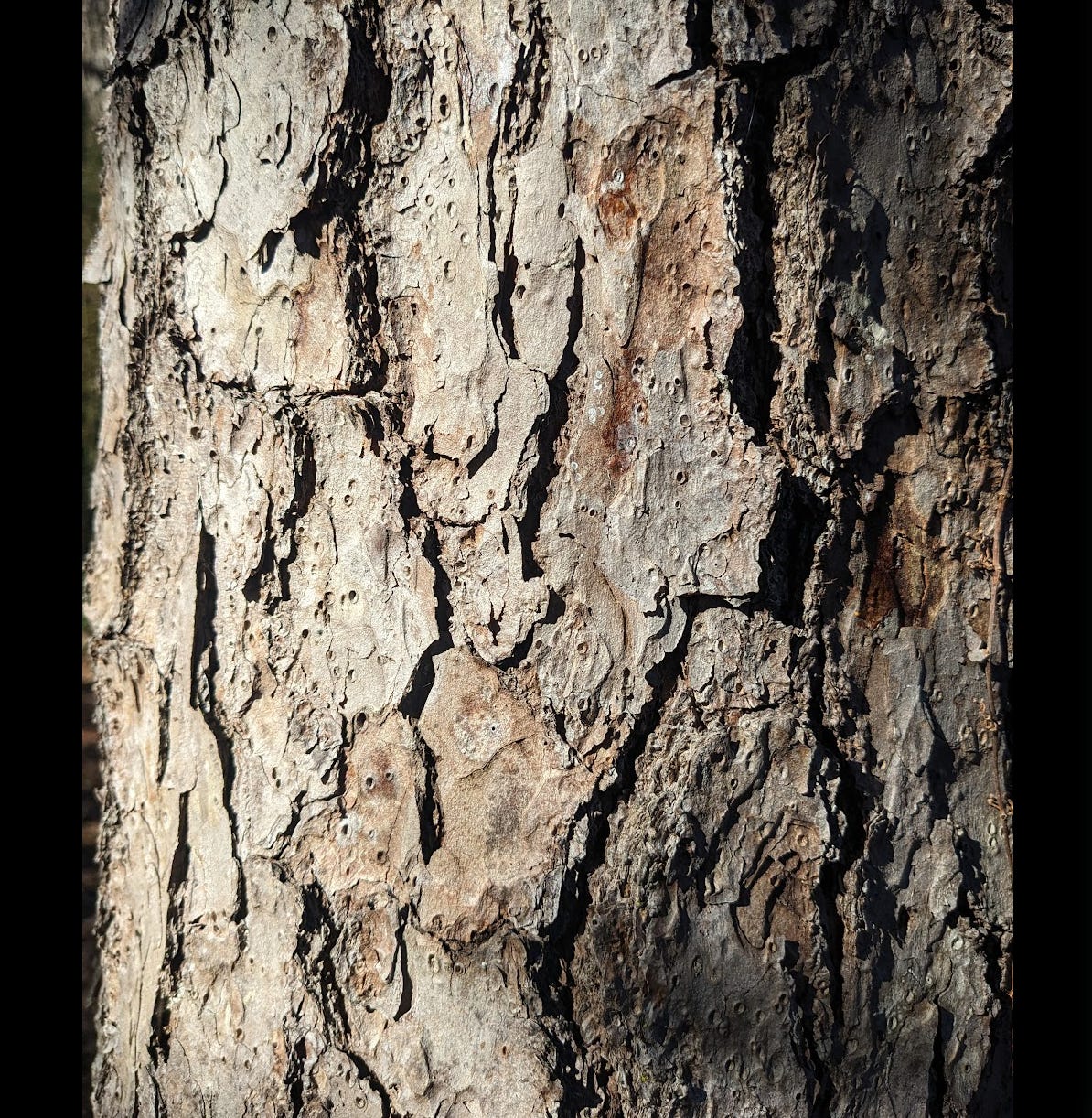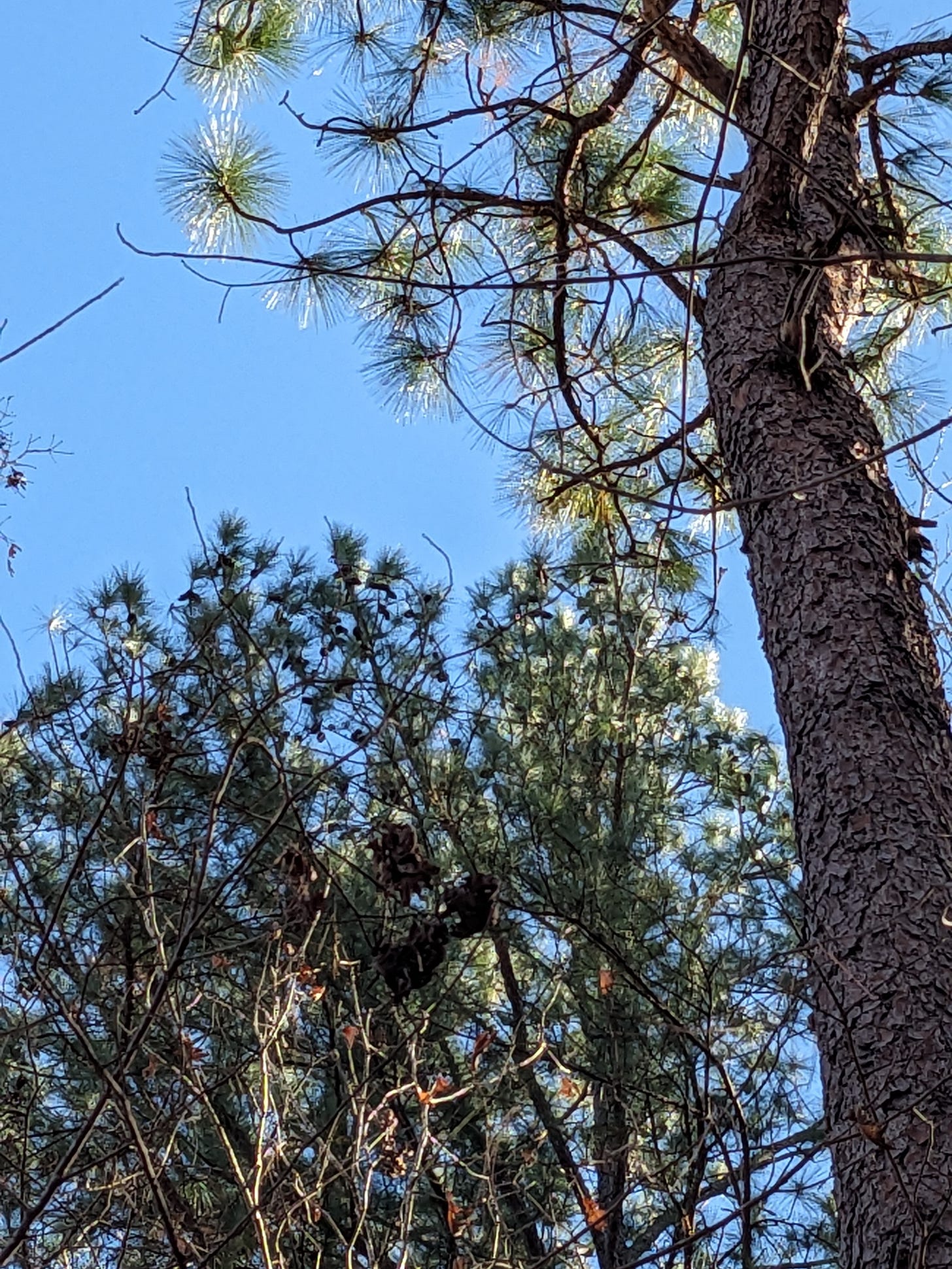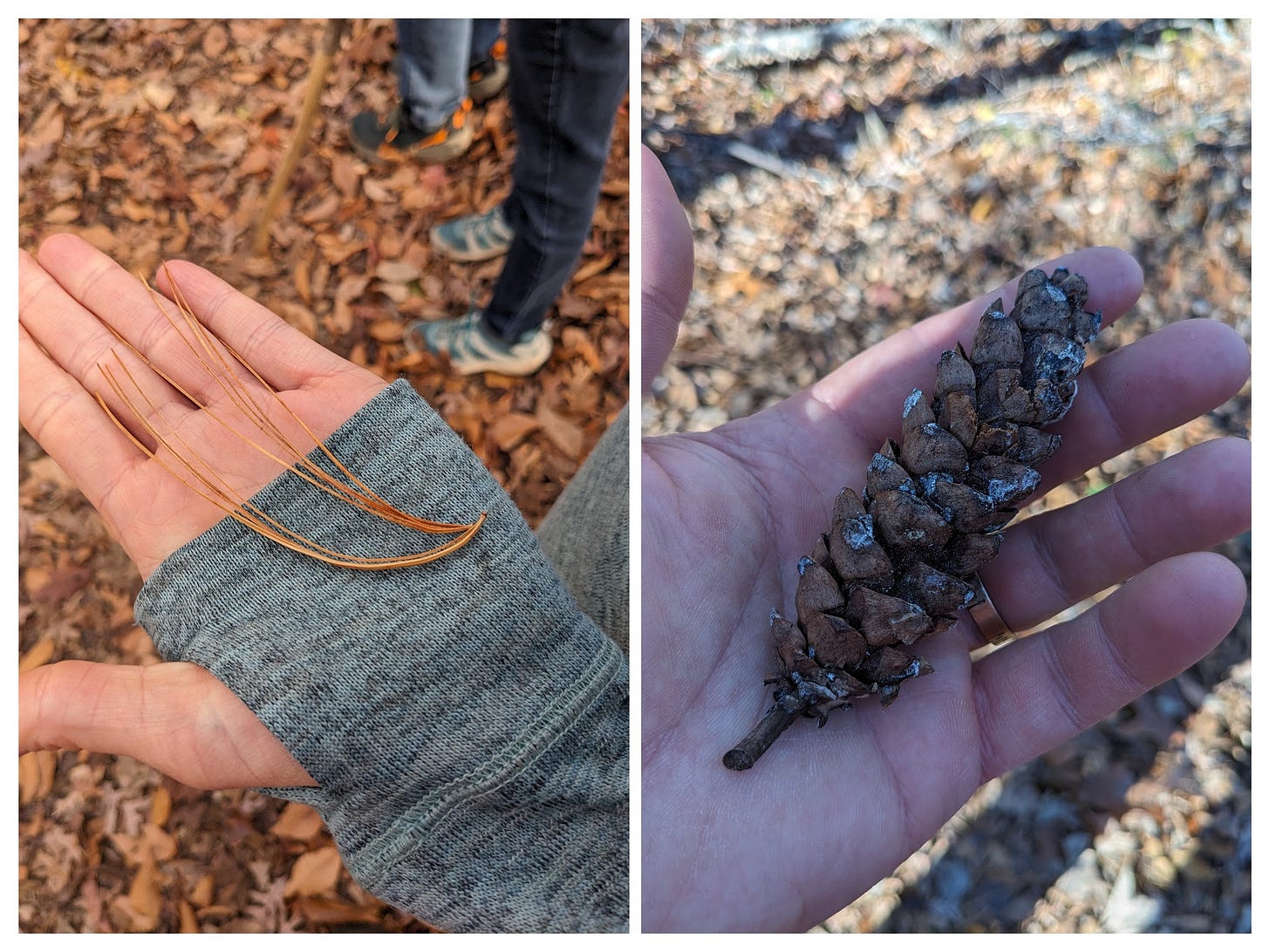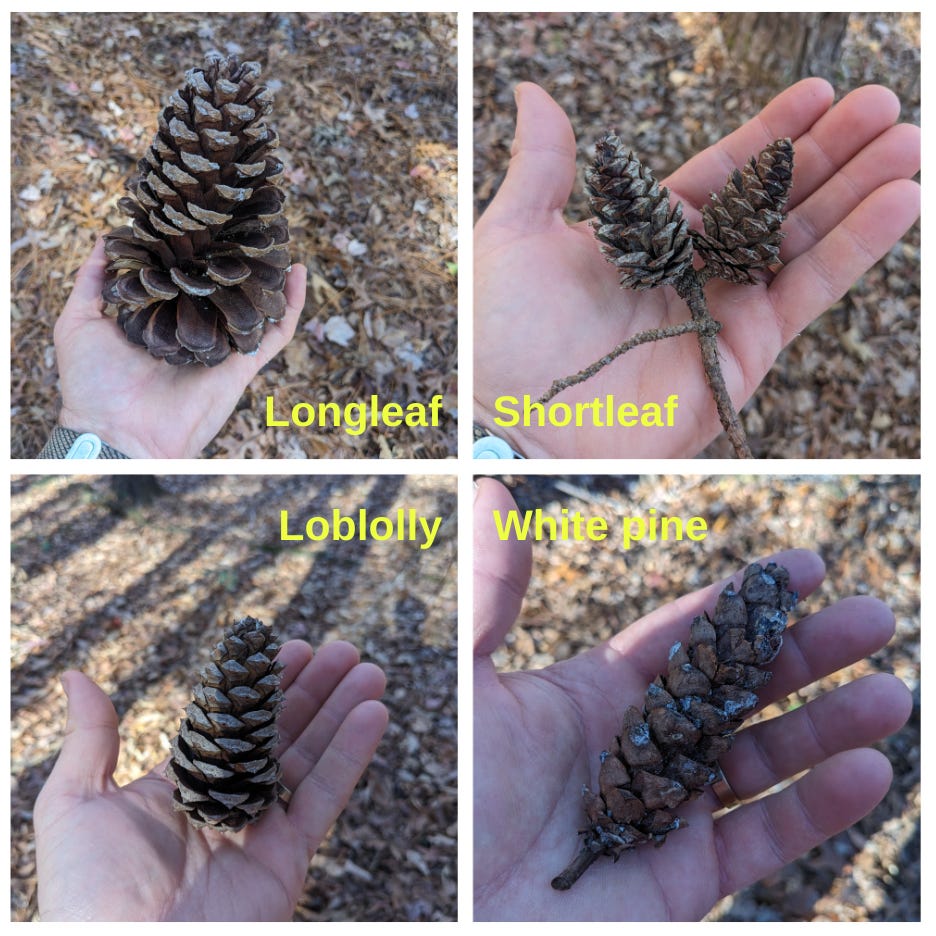This year, living in the “land of the pines” has drawn my attention to, well, the pines. I read a poem by the famous haiku poet Issa:
…ah… ah… … a night warbler sings… …the moon hangs in the pines…
And it got me thinking. What do I know about our pines? The Ravens Rock State Park has a great exhibit on the natural/geologic history of the Piedmont, I remember reading that it used to be all pine, not deciduous. Those came later. Similar story from the NC Art Museum, “Hundreds of years ago, the central Piedmont in North Carolina was covered with meadows rich in biodiversity. Meadows grew in openings between pine savannas maintained by both naturally occurring and human-ignited fires.”
Today, we no longer have endless “pine savannas,” yet we are still the land of the pines. Which ones are in my backyard?
Loblolly (pinus taeda)
Ha. Now that I know a little about pines, it’s funny that I had to Google this. Nowadays, loblolly pines are ubiquitous and by far the most common in our area. So the easiest way to know if you have a loblolly, is just to assume you do.
Apart from that, you can look for thick plated bark with deep grooves between the bark, needles in bunches of three, and cones that fit in your hand and have sharp points (picture below). Don Pelly, on a recent tree identification hike sponsored by Grand Trees of Chatham, suggested we could remember it by its Latin name of all things — pinus taeda’s cone, when you grip it, it’s like a hot potato you can’t grip it long! “Pinus taeda” — “hot potato” — get it? The loblolly cone is spiny (not hot like a baked tater), but it’s an easy way to know.
Here at home, we have a dozen or so loblolly pines. Most of ours are massive, 2-3 feet across at the base. For years I’ve kicked the cones out the way, having learned how prickly they are to pick up and toss.
Shortleaf pine (pinus echinata)
Another one we have at home is the shortleaf pine. It’s very different from loblolly, and much less common, though still relatively easy to find in the area.
Shortleaf pines have many small cones, shorter needles in groups of two, and papery layers of bark that don’t have the deep grooves of loblolly. The bark frequently has little round “resin holes” which helps in identifying, too. You can see this pretty prominently in the photo below.
Longleaf pine (pinus palustris)
This is the grand daddy pine of the Carolinas. We do not have these at home, but I was fortunate to find two of them at the White Pines Nature Preserve. These pines once dominated the eastern United States — according to the Longleaf book, they stretched across 90 million acres, of which perhaps 2 million remain today, and were famous even in Great Britain, known for their strength and durability for homes and ships.
The longleaf is distinctive. The bunches of needles have been described like a Dr. Seuss tree, with remarkable “pom-pom” shapes at the end of each branch. The needles are in bundles of three and can be a foot long, or more. The bark is papery like the shortleaf, with grooves like the loblolly (though not as deep or consistent), and the cones are large — 6-12 inches.
On the forest floor, the cones are the easiest way to know it’s a longleaf. Looking up, the globe-shaped bunches of needles are striking, especially when compared to the loblolly or other pines. In the following photo, the longleaf is the nearer tree in the top-half of the photo, with glossy globes of needles suspended in the air. The loblolly is thicker, has many cones, and shorter needles, lower down in the photo.
White pine (pinus strobus)
Our area is lucky to have the White Pines Nature Preserve, which as the name suggests is home to quite a number of white pines. Like the longleaf, these pines are no longer common, due to logging and the warming Piedmont. They can be found easily at the nature preserve, due to the unique ecology of north slopes and cooler temperatures at the confluence of the Rocky and Deep rivers.
White pines are identifiable by the cones, which are spotted or tinged with white, and the medium-length needles in bunches of five.
Cones are an easy differentiator
Walking through the forest, it is pretty easy to find cones on the ground, and these tell you a lot about which tree you are under. As shown in this photo collage:
More pines
There are so many more pines! In Carolina, we have Virginia pines, theoretically also in our area though not sure where to find them. We also have pitch pines and table mountain pines in the mountains, pond pine and slash pine by the coast, and possibly red pine though I understand it’s more likely found in the northeastern United States.
Out west, there is the classic ponderosa pine, lodge pole pine (also known as “twisted” or “shore” pine), western white pine, and the biggest baddest pines, sugar pines.
In Japan, there are classically black pines and red pines. The former is found at the seacoast and has traditional male associations. The latter is found in the mountains and hills, and has traditional female associations. That’s all based on cursory yet interested reading; more to come.
Not pines
There are many kinds of evergreen trees, all falling into the family Pinaceae (of which pines are 1 genus). A quick list from my notes…
Spruce - needles all along the branch, sharp, cones point down
Fir - needles all along the branch, pointed up, cones point up
Douglas-fir - another evergreen; not a true fir
Hemlock - shorter softer needles, all along the branch
Cedar - true cedar is like fir, but native to the Mediterranean and Himalayas
Juniper - blue seed cones that look like (and we call them) berries; interestingly, eastern red cedar is actually a juniper
Arborvitae - flat needle leafs, softer; "northern white cedar," "western red cedar,” but not true cedars
Redwood - coastal giants
Yew - toxic with red berries

